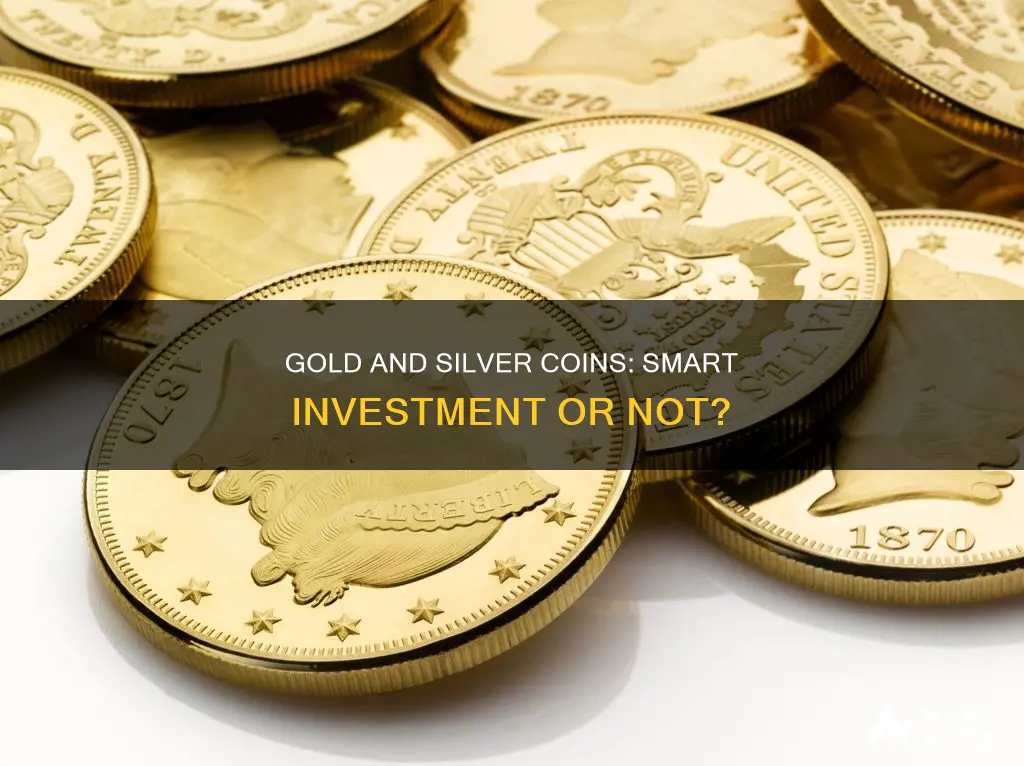
Gold and silver have been considered valuable commodities for centuries, but are they good investments? Gold and silver coins can be a good investment for those looking to diversify their portfolios and hedge against inflation. Gold is often seen as a safe haven asset, while silver is more volatile but offers greater short-term opportunities for profit. However, investing in precious metals comes with risks, including price volatility and storage costs. Ultimately, the decision to invest in gold or silver depends on an individual's financial goals, risk tolerance, and market outlook.
| Characteristics | Values |
|---|---|
| Long-term returns | Gold has historically had better long-term returns than silver. |
| Inflation hedge | Gold is often considered a hedge against inflation. Silver also has a high correlation with inflation but is not as solid as gold. |
| Speculative uses | Gold is primarily an investment asset, while silver is an industrial one. |
| Volatility | Silver tends to be more stable but can be highly volatile in the short term. |
| Affordability | Silver is more affordable than gold. |
| Diversification | Gold and silver are both metals that attract traders and investors, particularly during times of economic uncertainty. |
What You'll Learn

Gold and silver as a hedge against inflation
Gold and silver are often seen as good investments to hedge against inflation. Both precious metals have been used as stores of value and safe-haven assets for thousands of years.
Gold, in particular, has a reputation as a hedge against inflation and a store of value through market volatility. It is also seen as a safe-haven asset when the economy sours and stock and bond prices decline. During periods of high inflation, investors often flock to gold to protect the value of their money. For example, in 2020, gold prices rose 21% between the announcement of COVID-19 and the end of the year.
Gold's value is also linked to the US dollar. When the US dollar weakens, gold becomes more attractive to investors holding other currencies. This is because a weak dollar makes gold cheaper for investors holding stronger currencies.
Silver also has its advantages as an investment. Silver is more affordable than gold, making it a more divisible investment asset. Silver also has a wide range of industrial applications, including in electronics, solar cells, and automotive manufacturing. This means that during periods of economic growth and stability, silver can be a good investment.
However, it is important to note that gold and silver have not performed exceptionally well over the long term. Between 1925 and 2020, gold returned 4.87% compounded annually, while silver returned 3.46%. When adjusted for inflation, these returns are not particularly impressive.
Additionally, investing in gold and silver comes with distinct costs and risks. Physical gold and silver require secure storage and insurance, which can add to the overall cost of the investment.
Overall, gold and silver can be good investments to hedge against inflation, but investors should carefully consider the risks and costs associated with these precious metals before investing.
A Beginner's Guide: Investing in Bitcoin in Pakistan
You may want to see also

Gold and silver as a safe haven asset
Gold and silver are often viewed as safe-haven assets, particularly in times of economic uncertainty. They are seen as a hedge against inflation and a store of value through market ups and downs.
Gold, in particular, has a long history as a safe-haven asset. It has been used as a currency since around 560 B.C.E. when merchants created a standardised and easily transferable form of money in the form of a gold coin. This history has given gold an enduring value and, as a finite resource, it has successfully preserved wealth throughout thousands of generations.
Silver, too, has been used as a currency and is widely recognised as a critical industrial commodity. It is the best conductor of heat and electricity and has unique reflective properties, making it indispensable for solar power.
However, the prices of gold and silver can be extremely volatile and unstable, and there is no guarantee that their value will increase along with inflation. They also do not produce cash flow, and investors may have to wait years for their value to increase.
Overall, gold and silver can be a good safe-haven asset to include in an investment portfolio, particularly in volatile or unpredictable markets, but they should be balanced with other investments to reduce risk and preserve capital over time.
Coinbase's Funding: A Deep Dive into Investments
You may want to see also

Gold and silver's performance over time
Gold and silver have historically been considered reliable stores of wealth and value. Over the last century, the price of gold has increased significantly. In 1925, the price of an ounce of gold was $20.63, and by the end of 2020, it had risen to $1,893.66, resulting in a compounded annual return of 4.87%.
Gold is often seen as a safe haven asset and a hedge against inflation. During times of economic uncertainty, investors tend to flock to gold to protect their wealth. It is also a good diversifier for a portfolio as it is not correlated to stocks, bonds, or real estate.
Silver, on the other hand, has not performed as well as gold over the long term. An ounce of silver was priced at $0.68 at the end of 1925 and $17.14 at the end of 2020, resulting in a compounded annual return of 3.46%. Silver is more volatile than gold, with higher highs and lower lows, making it a riskier investment option. However, silver is more affordable than gold, making it a popular choice for smaller investors.
Silver is also an industrial metal with applications in electronics and solar cells. It is the best conductor of heat and electricity and has unique reflective properties. During periods of economic stability and growth, silver tends to perform better.
In summary, gold has a better track record than silver over long periods, but silver presents greater short-term opportunities to profit due to its higher volatility.
The Next Big Thing: What's Outpacing Bitcoin?
You may want to see also

The speculative uses of gold and silver
Gold and silver are both metals that attract traders and investors, especially during times of economic uncertainty. Gold is typically used as a store of value and has relatively limited industrial applications. Silver, on the other hand, is widely recognised as a critical industrial commodity with a wide range of applications.
Gold is often used as a hedge against inflation and a store of value through market ups and downs. It is also seen as a safe-haven asset when the economy turns sour, and the prices of stocks and bonds decline. Silver, in comparison, tends to be more stable and rises with economic growth. It is also a safe-haven asset in tougher times.
Gold is primarily an investment asset, with investments and related sectors accounting for nearly 90% of the total demand for the metal in 2021. The remaining 10% was consumed in industrial activities. Silver, on the other hand, is an industrial metal with indispensable uses in electronics and solar cells. Silver is the best conductor of heat and electricity and has unique reflective properties.
Gold is also a good investment option for those who want to diversify their portfolios. It is not correlated to stocks, bonds, or real estate, meaning that it can be a place of relative safety even when other assets are declining. Silver, due to its lower price per ounce, is a more divisible investment asset. It is also a good option for investors looking for short-term opportunities to profit, as silver prices are more volatile than gold prices.
Gold and silver coins are a popular way to invest in these metals. Gold coins, such as the American Gold Eagle, Canadian Gold Maple Leaf, and South African Krugerrand, are available in various denominations and offer a tangible and stable investment option. Silver coins, such as the American Silver Eagle, Canadian Silver Maple Leaf, and Somalian Silver Elephant, are also a great place to start building an investment portfolio due to their government backing and guaranteed silver content.
However, it is important to note that investing in gold and silver coins comes with certain risks, such as the risk of theft and the lack of dividends or interest payments. Additionally, the prices of gold and silver can be highly volatile and unstable, and there is no guarantee that they will increase with inflation.
Hong Kong Bitcoin Investment: A Beginner's Guide
You may want to see also

The volatility of gold and silver
Gold and silver are both volatile assets, with their prices fluctuating significantly over time. In the short term, silver can be highly volatile due to its relatively low liquidity, especially in the financial market. This makes it a riskier bet than gold. However, in the long term, gold has historically had a better track record, with higher returns than silver.
Gold and silver prices tend to move in tandem when measured against depreciating fiat currencies. Silver prices are more volatile, with higher highs and lower lows, and short-term silver-to-gold ratios can exceed 80:1 and fall below 40:1. This higher volatility presents greater short-term opportunities for profit but also increases risk.
Gold is often seen as a hedge against inflation, with its price typically appreciating as the value of money decreases. However, this is not always the case, and there is no guarantee that gold will increase in value during inflationary periods. Gold's price is also influenced by interest rates, which can divert investments to the debt market.
The demand for gold and silver also stems from different sources. Gold is primarily an investment asset, while silver is more of an industrial metal. Gold has relatively limited industrial applications, whereas silver is used in electronics, solar cells, and other products. As a result, silver demand is driven more by economic stability and growth, whereas gold is sought after as a safe-haven asset during turbulent economic periods.
In terms of investing in physical gold and silver, there are risks associated with theft and storage. Additionally, tangible gold and silver do not provide any perks of dividends or interest payments. As a result, investors may opt for alternative ways to invest in these precious metals, such as through mining stocks, exchange-traded funds (ETFs), or gold certificates.
Bitcoin in India: Invest Now or Miss the Boat?
You may want to see also
Frequently asked questions
Gold is seen as a way to diversify your portfolio and hedge against inflation. It can also be a safe-haven asset when the economy turns sour. However, gold has disappointed investors in different historical periods and its value is based on emotion.
Silver is a critical industrial commodity with high utility. It is the best conductor of heat and electricity and has unique reflective properties. Silver prices are more volatile than gold prices, presenting greater short-term opportunities to profit, albeit with higher risk.
Gold coins can stabilise your portfolio during market declines and safeguard against inflation. Gold tends to increase in value when other investments decline. You also don't have to pay capital gains tax until you sell.
There is a risk of theft when buying gold coins. Unlike stocks and bonds, gold is not an investment in company growth and you won't receive dividends or interest payments. You may also have to wait years for gold to increase in value.
Alternatives to buying gold coins include purchasing mining stocks, buying gold with your IRA investments, or buying gold mining stock, gold certificates, or exchange-traded products.







